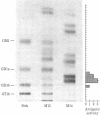Abstract
Two monospecific human antibodies (anti-OFA-I-1 and anti-OFA-I-2) produced in vitro by lymphoblast cell lines originating from melanoma patients have been shown previously to recognize cell surface antigens (OFA-I-1 and OFA-I-2) on human tumors and fetal brain: OFA-I-1 is expressed on a variety of human tumors, while OFA-I-2 has been detected only on tumors of neuroectodermal origin. Evidence presented in this report suggests that the two antigens expressed by a cultured human melanoma cell line (M14) are chemically distinct and that OFA-I-2 is a cell surface glycolipid, ganglioside GD2: GalNAc beta 1 leads to 4 NeuAc alpha 2 leads to 8NeuAc alpha 2 leads to 3 Gal beta 1 leads to 4Glc-ceramide.
Full text
PDF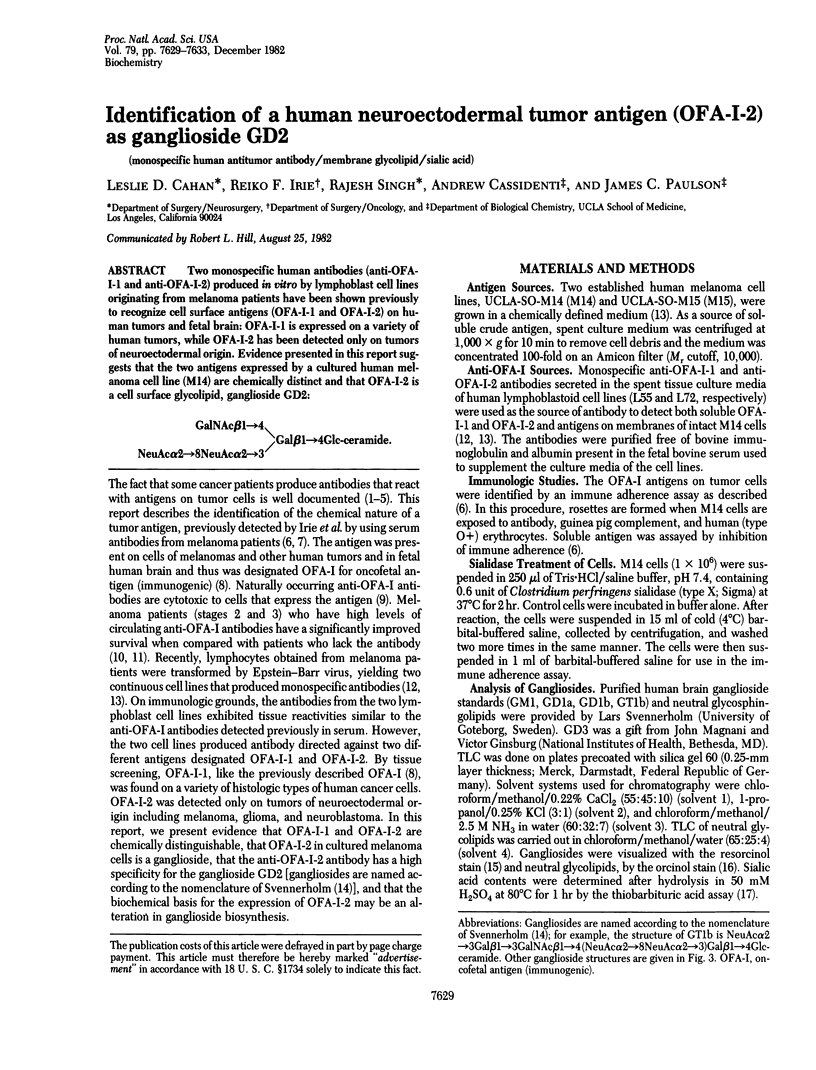
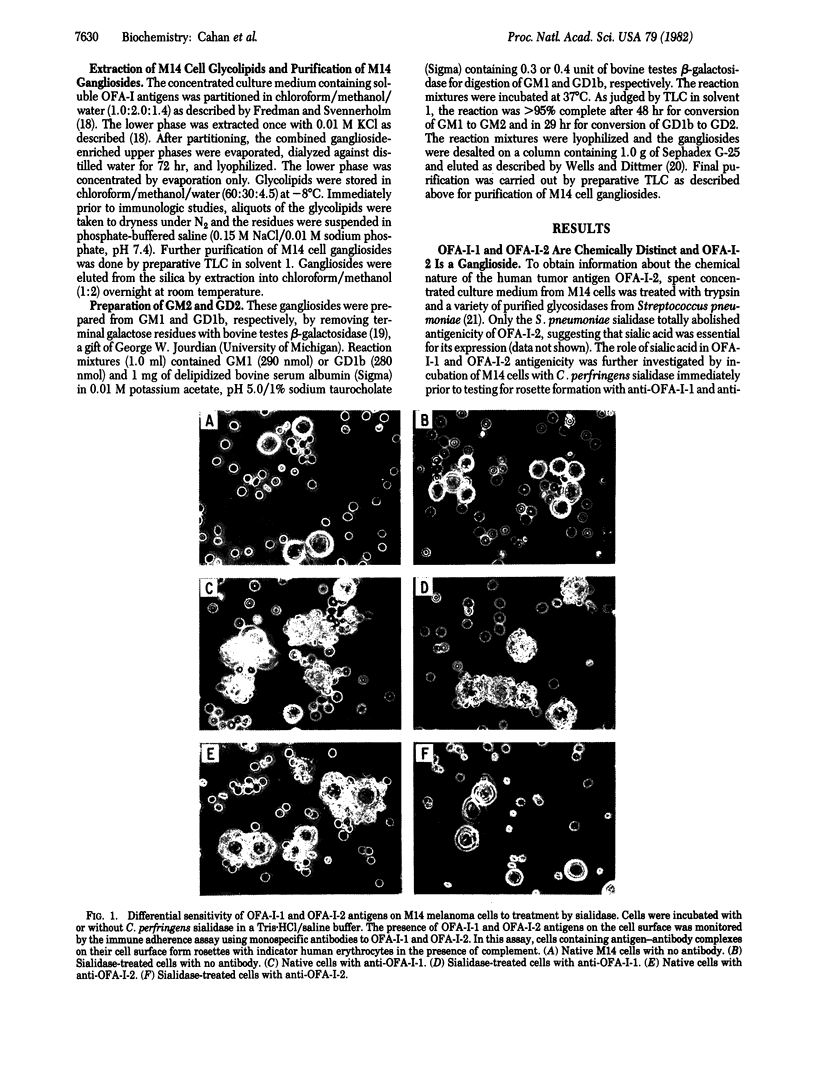
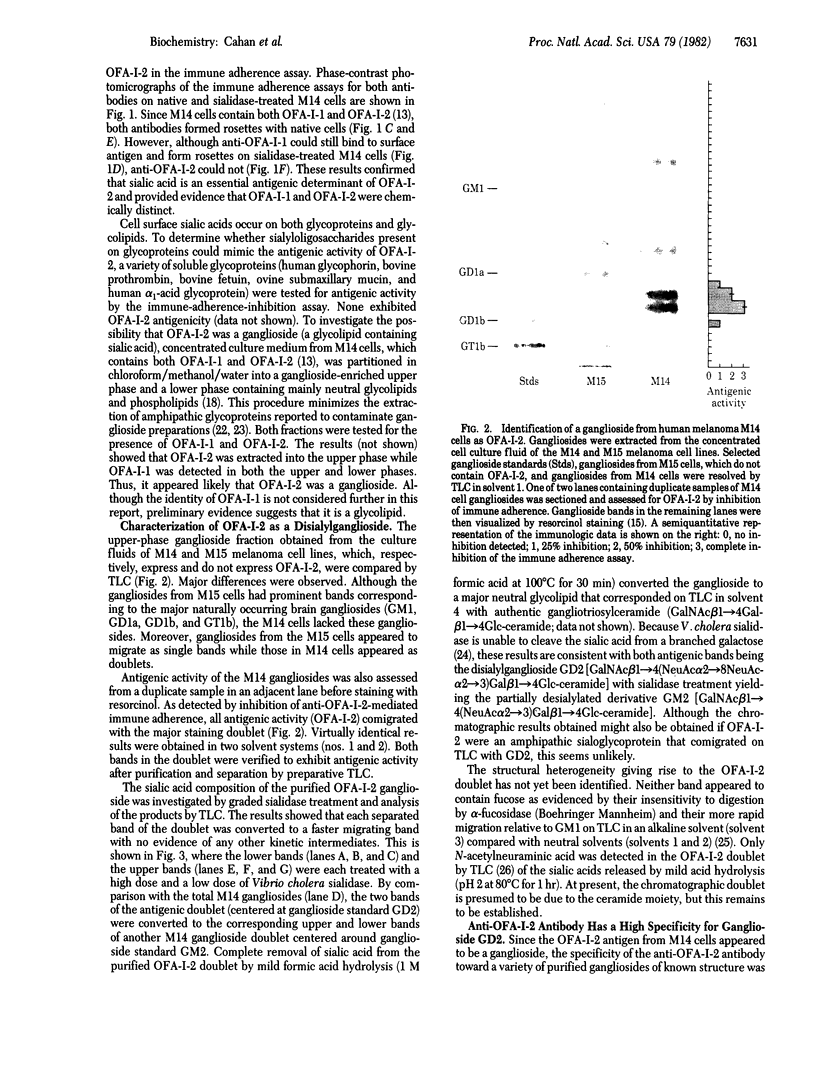
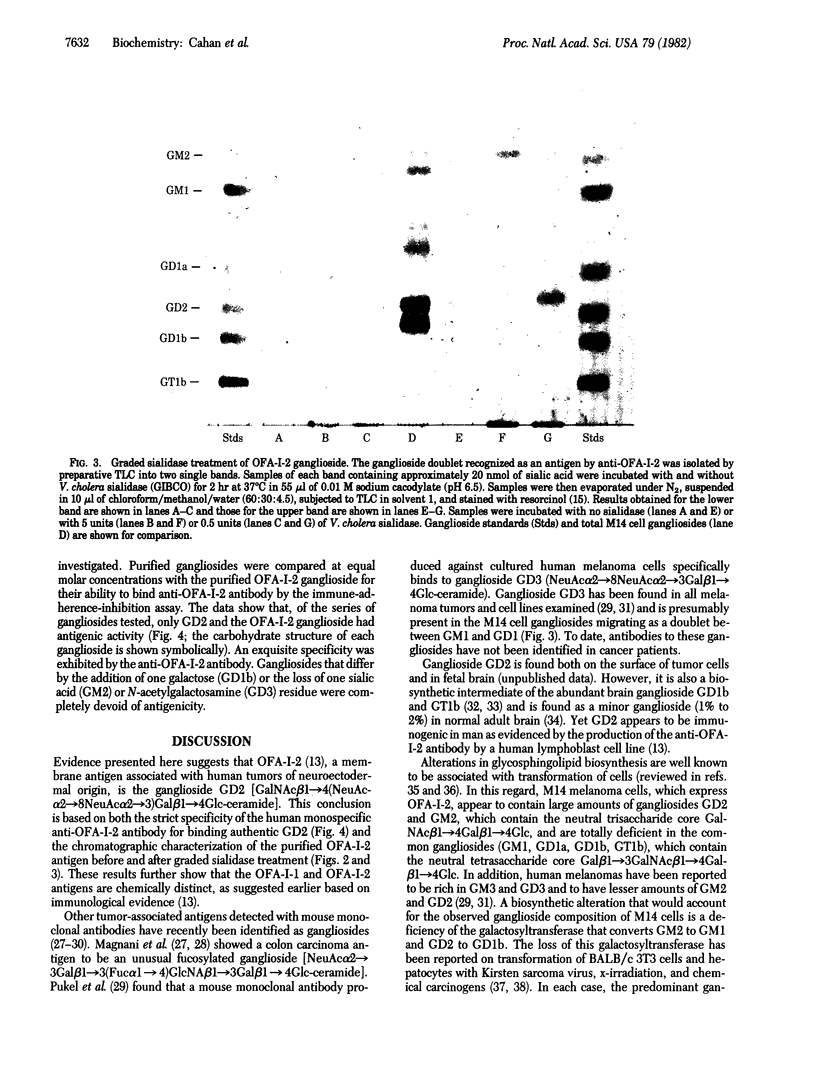
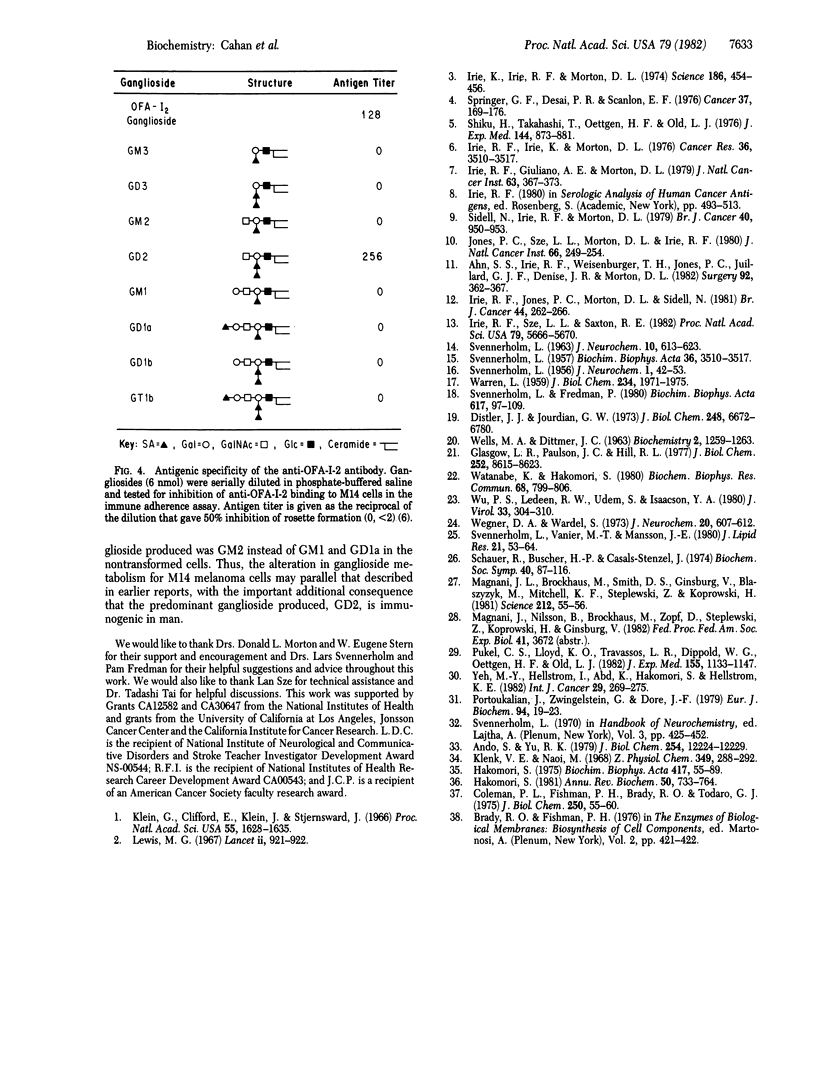
Images in this article
Selected References
These references are in PubMed. This may not be the complete list of references from this article.
- Ahn S. S., Irie R. F., Weisenburger T. H., Jones P. C., Juillard G., Roe D. J., Morton D. L. Humoral immune response to intralymphatic immunotherapy for disseminated melanoma: correlation with clinical response. Surgery. 1982 Aug;92(2):362–367. [PubMed] [Google Scholar]
- Ando S., Yu R. K. Isolation and characterization of two isomers of brain tetrasialogangliosides. J Biol Chem. 1979 Dec 10;254(23):12224–12229. [PubMed] [Google Scholar]
- Coleman P. L., Fishman P. H., Brady R. O., Todaro G. J. Altered ganglioside biosynthesis in mouse cell cultures following transformation with chemical carcinogens and x-irradiation. J Biol Chem. 1975 Jan 10;250(1):55–60. [PubMed] [Google Scholar]
- Glasgow L. R., Paulson J. C., Hill R. L. Systematic purification of five glycosidases from Streptococcus (Diplococcus) pneumoniae. J Biol Chem. 1977 Dec 10;252(23):8615–8623. [PubMed] [Google Scholar]
- Hakomori S. Glycosphingolipids in cellular interaction, differentiation, and oncogenesis. Annu Rev Biochem. 1981;50:733–764. doi: 10.1146/annurev.bi.50.070181.003505. [DOI] [PubMed] [Google Scholar]
- Hakomori S. Structures and organization of cell surface glycolipids dependency on cell growth and malignant transformation. Biochim Biophys Acta. 1975 Mar 20;417(1):55–89. doi: 10.1016/0304-419x(75)90008-6. [DOI] [PubMed] [Google Scholar]
- Irie K., Irie R. F., Morton D. L. Evidence for in vivo reaction of antibody and complement to surface antigens of human cancer cells. Science. 1974 Nov 1;186(4162):454–456. doi: 10.1126/science.186.4162.454. [DOI] [PubMed] [Google Scholar]
- Irie R. F., Giuliano A. E., Morton D. L. Oncofetal antigen: a tumor-associated fetal antigen immunogenic in man. J Natl Cancer Inst. 1979 Aug;63(2):367–373. [PubMed] [Google Scholar]
- Irie R. F., Irie K., Morton D. L. A membrane antigen common to human cancer and fetal brain tissues. Cancer Res. 1976 Sep;36(9 Pt 2):3510–3517. [PubMed] [Google Scholar]
- Irie R. F., Jones P. C., Morton D. L., Sidell N. In vitro production of human antibody to a tumour-associated foetal antigen. Br J Cancer. 1981 Aug;44(2):262–266. doi: 10.1038/bjc.1981.178. [DOI] [PMC free article] [PubMed] [Google Scholar]
- Irie R. F., Sze L. L., Saxton R. E. Human antibody to OFA-I, a tumor antigen, produced in vitro by Epstein-Barr virus-transformed human B-lymphoid cell lines. Proc Natl Acad Sci U S A. 1982 Sep;79(18):5666–5670. doi: 10.1073/pnas.79.18.5666. [DOI] [PMC free article] [PubMed] [Google Scholar]
- Jones P. C., Sze L. L., Liu P. Y., Morton D. L., Irie R. F. Prolonged survival for melanoma patients with elevated IgM antibody to oncofetal antigen. J Natl Cancer Inst. 1981 Feb;66(2):249–254. [PubMed] [Google Scholar]
- Klein G., Clifford P., Klein E., Stjernswärd J. Search for tumor-specific immune reactions in Burkitt lymphoma patients by the membrane immunofluorescence reaction. Proc Natl Acad Sci U S A. 1966 Jun;55(6):1628–1635. doi: 10.1073/pnas.55.6.1628. [DOI] [PMC free article] [PubMed] [Google Scholar]
- Klenk E., Naoi M. Uber eine Komponente des Gemisches der Gehirnganglioside, die durch Neuraminidaseeinwirkung in das Tay-Sachs-Gangliosid übergeht. Hoppe Seylers Z Physiol Chem. 1968 Mar;349(3):288–292. [PubMed] [Google Scholar]
- Lewis M. G. Possible immunological factors in human malignant melanoma in Uganda. Lancet. 1967 Oct 28;2(7522):921–922. doi: 10.1016/s0140-6736(67)90236-x. [DOI] [PubMed] [Google Scholar]
- Magnani J. L., Brockhaus M., Smith D. F., Ginsburg V., Blaszczyk M., Mitchell K. F., Steplewski Z., Koprowski H. A monosialoganglioside is a monoclonal antibody-defined antigen of colon carcinoma. Science. 1981 Apr 3;212(4490):55–56. doi: 10.1126/science.7209516. [DOI] [PubMed] [Google Scholar]
- Portoukalian J., Zwingelstein G., Doré J. F. Lipid composition of human malignant melanoma tumors at various levels of malignant growth. Eur J Biochem. 1979 Feb 15;94(1):19–23. doi: 10.1111/j.1432-1033.1979.tb12866.x. [DOI] [PubMed] [Google Scholar]
- Pukel C. S., Lloyd K. O., Travassos L. R., Dippold W. G., Oettgen H. F., Old L. J. GD3, a prominent ganglioside of human melanoma. Detection and characterisation by mouse monoclonal antibody. J Exp Med. 1982 Apr 1;155(4):1133–1147. doi: 10.1084/jem.155.4.1133. [DOI] [PMC free article] [PubMed] [Google Scholar]
- SVENNERHOLM L. CHROMATOGRAPHIC SEPARATION OF HUMAN BRAIN GANGLIOSIDES. J Neurochem. 1963 Sep;10:613–623. doi: 10.1111/j.1471-4159.1963.tb08933.x. [DOI] [PubMed] [Google Scholar]
- SVENNERHOLM L. The quantitative estimation of cerebrosides in nervous tissue. J Neurochem. 1956 May;1(1):42–53. doi: 10.1111/j.1471-4159.1956.tb12053.x. [DOI] [PubMed] [Google Scholar]
- Schauer R., Buscher H. P., Casals-Stenzel J. Sialic acids: their analysis and enzymic modification in relation to the synthesis of submandibular-gland glycoproteins. Biochem Soc Symp. 1974;(40):87–116. [PubMed] [Google Scholar]
- Shiku H., Takahashi T., Oettgen H. F. Cell surface antigens of human malignant melanoma. II. Serological typing with immune adherence assays and definition of two new surface antigens. J Exp Med. 1976 Oct 1;144(4):873–881. doi: 10.1084/jem.144.4.873. [DOI] [PMC free article] [PubMed] [Google Scholar]
- Sidell N., Irie R. F., Morton D. L. Oncofoetal antigen I: a target for immune cytolysis of human cancer. Br J Cancer. 1979 Dec;40(6):950–953. doi: 10.1038/bjc.1979.291. [DOI] [PMC free article] [PubMed] [Google Scholar]
- Springer G. F., Desai P. R., Scanlon E. F. Blood group MN precursors as human breast carcinoma-associated antigens and "naturally" occurring human cytotoxins against them. Cancer. 1976 Jan;37(1):169–176. doi: 10.1002/1097-0142(197601)37:1<169::aid-cncr2820370124>3.0.co;2-#. [DOI] [PubMed] [Google Scholar]
- Sundsmo J. S., Hakomori S. Lacto-N-neotetraosylceramide ("paragloboside") as a possible tumor-associated surface antigen of hamster NILPY tumor. Biochem Biophys Res Commun. 1976 Feb 9;68(3):799–806. doi: 10.1016/0006-291x(76)91216-x. [DOI] [PubMed] [Google Scholar]
- Svennerholm L., Fredman P. A procedure for the quantitative isolation of brain gangliosides. Biochim Biophys Acta. 1980 Jan 18;617(1):97–109. doi: 10.1016/0005-2760(80)90227-1. [DOI] [PubMed] [Google Scholar]
- Svennerholm L., Vanier M. T., Månsson J. E. Krabbe disease: a galactosylsphingosine (psychosine) lipidosis. J Lipid Res. 1980 Jan;21(1):53–64. [PubMed] [Google Scholar]
- WARREN L. The thiobarbituric acid assay of sialic acids. J Biol Chem. 1959 Aug;234(8):1971–1975. [PubMed] [Google Scholar]
- WELLS M. A., DITTMER J. C. THE USE OF SEPHADEX FOR THE REMOVAL OF NONLIPID CONTAMINANTS FROM LIPID EXTRACTS. Biochemistry. 1963 Nov-Dec;2:1259–1263. doi: 10.1021/bi00906a015. [DOI] [PubMed] [Google Scholar]
- Wenger D. A., Wardell S. Action of neuraminidase (EC 3.2.1.18) from Clostridium perfringens on brain gangliosides in the presence of bile salts. J Neurochem. 1973 Feb;20(2):607–612. doi: 10.1111/j.1471-4159.1973.tb12159.x. [DOI] [PubMed] [Google Scholar]
- Wu P. S., Ledeen R. W., Udem S., Isaacson Y. A. Nature of the Sendai virus receptor: glycoprotein versus ganglioside. J Virol. 1980 Jan;33(1):304–310. doi: 10.1128/jvi.33.1.304-310.1980. [DOI] [PMC free article] [PubMed] [Google Scholar]
- Yeh M. Y., Hellström I., Abe K., Hakomori S., Hellström K. E. A cell-surface antigen which is present in the ganglioside fraction and shared by human melanomas. Int J Cancer. 1982 Mar 15;29(3):269–275. doi: 10.1002/ijc.2910290308. [DOI] [PubMed] [Google Scholar]









